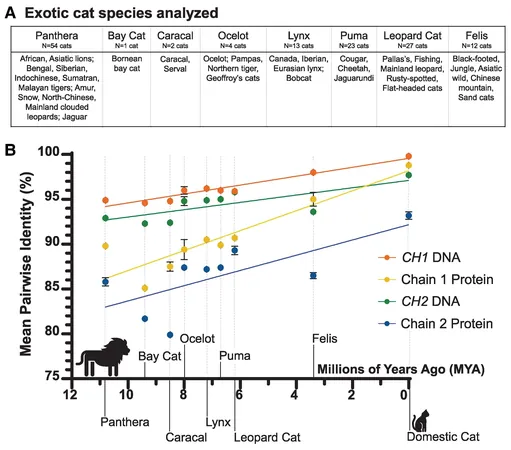
Breakthrough in Cat Allergy Research: Could Hypoallergenic Cats Soon Be a Reality?
2024-11-26
Author: Wei Ling
Introduction
A groundbreaking study suggests that the dream of having hypoallergenic cats may soon become a reality, thanks to advances in gene editing technology. Researchers, led by Martin D. Chapman, delved into the genetics behind Fel d 1, a protein responsible for triggering allergic reactions in approximately 15% of the global population. Their findings were published in the esteemed journal PNAS Nexus.
What is Fel d 1?
Fel d 1 is produced in various glands of cats, including sebaceous, salivary, perianal, and lachrymal glands. Although the exact purpose of this allergenic protein remains largely unknown, the researchers examined genes CH1 and CH2 that code for Fel d 1. Their comprehensive analysis included 276 domestic and exotic felines, from house cats to big cats like cougars, lions, and tigers. This extensive research revealed that the CH1 and CH2 genes seem to have been actively selected over generations, hinting that they might provide some evolutionary advantage to these animals.
Beyond Allergies
Interestingly, Fel d 1 may play roles beyond allergy, such as immune regulation, skin protection, or even chemical communication among cats. Yet, the study's findings reveal that cats modified to lack the CH2 gene maintain their health and functionality. This suggests that the allergenic protein might be nonessential for survival or that its role varies among different cat species.
Remarkable Findings
The research identified two remarkable examples: a cougar and a black-footed cat—both of which exhibited mutations likely preventing the expression of Fel d 1. This further underscores the possibility that the allergenic properties associated with domestic cats may not be critical for their well-being.
Utilizing Gene Editing
In light of these discoveries, the authors propose utilizing CRISPR technology to delete the genes CH1 and CH2, paving the way for the creation of hypoallergenic cats. For allergy sufferers, this breakthrough offers potential hope—a future where they could enjoy the companionship of a cat without the discomfort of allergic reactions.
Conclusion
The implications are substantial; if successful, this gene-editing approach could revolutionize pet ownership for millions of people worldwide. Stay tuned as this exciting field of research continues to develop!


 Brasil (PT)
Brasil (PT)
 Canada (EN)
Canada (EN)
 Chile (ES)
Chile (ES)
 España (ES)
España (ES)
 France (FR)
France (FR)
 Hong Kong (EN)
Hong Kong (EN)
 Italia (IT)
Italia (IT)
 日本 (JA)
日本 (JA)
 Magyarország (HU)
Magyarország (HU)
 Norge (NO)
Norge (NO)
 Polska (PL)
Polska (PL)
 Schweiz (DE)
Schweiz (DE)
 Singapore (EN)
Singapore (EN)
 Sverige (SV)
Sverige (SV)
 Suomi (FI)
Suomi (FI)
 Türkiye (TR)
Türkiye (TR)